Table of contents
Do you know the benefits of plums?
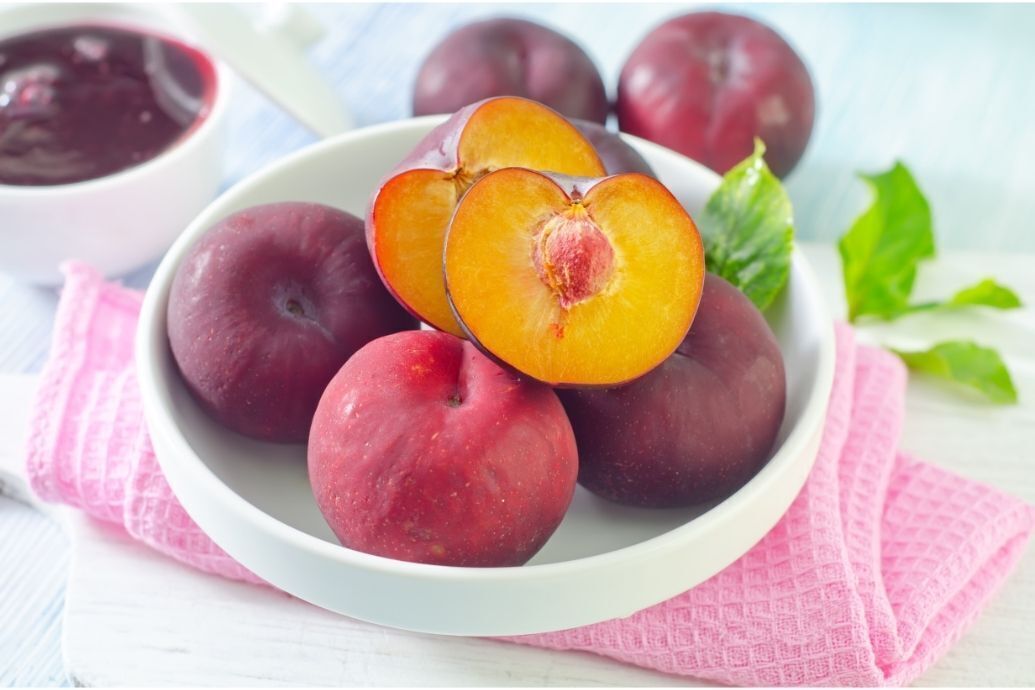
Plums are an extremely nutritious fruit with a huge number of health benefits. They can also be found in 4 different varieties and colors, each with a unique taste and purpose.
A source of vitamins, minerals, fiber and antioxidants, these little fruits are capable of reducing the risk of and preventing various chronic diseases of the body and mind.
In addition to coming in a variety of colors, plums can also be easily found in dried form. This type is very important for the intestinal and bone systems. Read on and see all the benefits this tasty fruit brings!
Understanding the plum
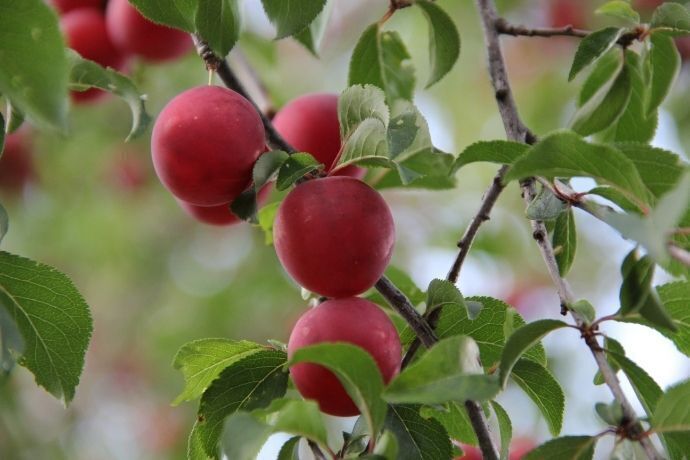
Found in countries with temperate and subtropical climates, the plum's main producer is China, followed by the United States, Romania and Germany. Find out more about its origins and properties below.
Origin and characteristics of the plum fruit
Belonging to the same family as peaches, nectarines and apricots, plums are very diverse because they can be large or small, with red, black, green or yellow skins, as well as pink, yellow or orange flesh.
Historians have yet to reach a consensus when it comes to their origins. For some, plum trees first grew in China thousands of years ago, and only after a while did they make their way to Japan, parts of Europe and America.
Other researchers have located the first plum trees in the Caucasus Mountains, near the Caspian Sea. They believe that the fruit made its way to Rome around 200 B.C. and then traveled to northern Europe.
Plum properties and vitamins
With its high nutritional value, the plum can be considered a superfood, whether fresh or dried. Check it out:
Fresh plum (100g):
- Calories: 46;
- Carbohydrates: 8g;
- Fiber: 1g;
- Sugars: 7g;
- Vitamin A: 5% of the RDI (Recommended Daily Intake);
- Vitamin C: 10% of the RDI;
- Vitamin K: 5% of the RDI;
- Potassium: 3% of the RDI;
- Copper: 2% of the RDI;
- Manganese: 2% of the RDI;
Dried plums (28g):
- Calories: 67;
- Carbohydrates: 18g;
- Fiber: 2g
- Sugars: 11g;
- Vitamin A: 4% of the RDI;
- Vitamin K: 21% of the RDI;
- Vitamin B2: 3% of the RDI;
- Vitamin B3: 3% of the RDI;
- Vitamin B6: 3% of the RDI;
- Potassium: 6% of the RDI;
- Copper: 4% of the RDI;
- Manganese: 4% of the RDI;
- Magnesium: 3% of the RDI;
- Phosphorus: 2% of the RDI.
What are plums good for?
A source of various nutrients, such as vitamins, fibre and minerals, plums are the ideal fruit to eat when you want to have good digestion and optimize the process as a whole. This is because this fruit can make your intestines healthier, improving transit in the organ, strengthening it and making its performance more regular.
The presence of vitamin C helps to boost the immune system, build muscles and blood vessels. The combination of this nutrient with others makes the plum a great friend of your eyes too. In addition, it has great antioxidant power and also increases the feeling of satiety due to its soluble fibers.
Main types of plum
Plums can be eaten fresh, cooked, baked, in juices or dehydrated. But did you know that, as well as being versatile, this fruit can come in more than two thousand varieties? There are many different shapes, sizes, flavors, uses and colors.
For this reason, they are divided into 6 major groups: Japanese, American, ornamental, Damson, European and wild. However, here in Brazil the most common are yellow, black, green and red. Find out all about each type below.
Black plum
One of the best-known varieties, the black plum has a darker skin, rich in nutrients and fiber. It also stands out for being very sweet, a great substitute for sugar because it contains sorbitol, a type of natural sweetener.
In fact, anyone who suffers from a lazy bowel should already know about the benefits of this fruit. Consuming the fibre present in plums is perfect for optimizing and stimulating the functioning of intestinal transit.
Furthermore, as a source of potassium and antioxidants such as anthocyanins, it is able to protect cells from the action of free radicals, as well as being great for the cardiovascular system.
Red plum
Considered to be the most popular plum in the country, the red plum has a distinctive flavor that is sweet and slightly acidic. With its orange flesh, it is a source of various nutrients that are essential for the proper functioning of the body.
With the presence of flavonoid compounds and antioxidants, it has an anti-inflammatory action and even manages to reduce the chances of developing diseases such as cancer. Another positive point of this variety is that it is very good for maintaining healthy skin.
Rich in vitamin C, red plums help to boost the immune system, preventing seasonal illnesses such as the flu.
Yellow plum
Also known as Japanese plum or medlar, the yellow plum is a very juicy fruit with a slightly tart and sweet flavor. This variety won over the taste buds of Asian peoples thousands of years ago.
Unlike other plums, the yellow plum has a velvety, almost velvet-like skin. It is also one of the best sources of carotenoids, a substance that acts as an antioxidant. It is therefore excellent for skin health and can even help you get a tan.
Rich in vitamins, minerals and antioxidants, it helps strengthen immunity and prevents the development of certain diseases. It is also often compared to apples and pears because of its high sugar, acidity and pectin content.
Green plum
Highly nutritious but little known in Brazil, the green plum is widely used in confectionery because of its bitter taste. The skin can vary between greenish and yellowish tones, with a touch of light blue in some fruits.
Of Iranian origin and very popular in England and the United States, it is considered one of the most beneficial for health. In some places, the green plum is called Queen Claudia.
In addition, the fruit is low in calories and can be smaller in size than other varieties. It often appears in cakes and sweets in general, such as jams. In Portugal, for example, the fruit in syrup or candied is an accompaniment to desserts.
Prunes
Even when dehydrated, the prune preserves most of the nutrients it would have in its fresh version. The only exception is vitamin C, which ends up degrading during the dehydration process. It is therefore a great option for consuming the fruit, as it is practical and affordable.
One of its greatest benefits is the optimization of digestive function, as it regulates intestinal transit and consequently combats constipation.
Improved blood circulation and the prevention of cardiovascular diseases are other positive aspects of eating dried fruit.
Plum benefits
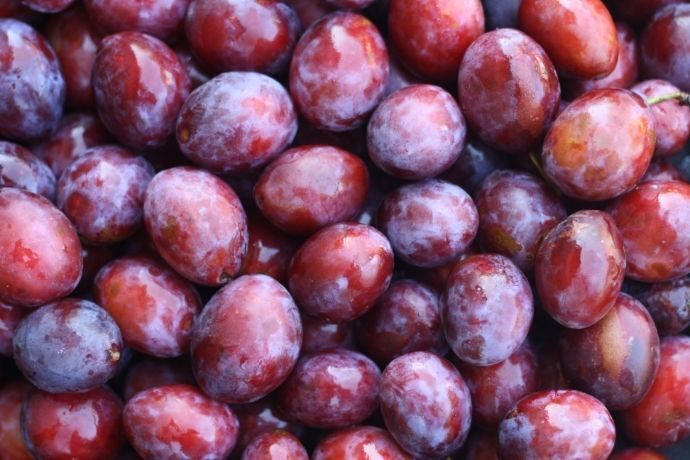
As plums contain many antioxidants, they are super-efficient at fighting free radicals that damage cells and can lead to the development of pathologies such as cancer. Here are all the benefits this fruit brings.
Strengthens the immune system
In its fresh version, the plum has a high concentration of vitamin C. To give you an idea, one unit contains around 10% of the basic daily requirement of the nutrient.
Thus, together with the action of antioxidants, the vitamin C present in plums helps to strengthen the immune system, preventing the development of illnesses such as colds, flu, sore throats and infections.
Interestingly, the yellow variety of the fruit has the highest levels of vitamin C.
Prevents cardiovascular diseases
Nutrients and phytochemicals present in plums are capable of reducing the inflammation that triggers cardiovascular disease. Regular consumption of the fruit, fresh or dried, also has a protective effect on organ health.
The results of a study showed that men diagnosed with high cholesterol had lower levels of bad cholesterol (LDL) after consuming prunes daily for approximately eight weeks.
It can be said that the positive effects that plums have on heart disease risk factors are due to their high fiber, potassium and antioxidant content.
Has an antioxidant function
Plums are rich in antioxidants, very important substances for reducing inflammation and protecting cells from damage caused by free radicals. In this way, they prevent cell and tissue damage, which can lead to diabetes, Alzheimer's, Parkinson's and cancer.
They are rich in polyphenol antioxidants, and studies have shown that plums contain more than double the amount of polyphenols than other popular fruits, such as nectarines and peaches.
In one study, the antioxidants in plums significantly reduced inflammatory markers associated with joint and lung diseases. Anthocyanins, for example, appear to be the most active antioxidants in this fruit.
Source of fiber
A source of dietary fiber, prunes, especially the dried version, are the best allies for good intestinal function. The amount of soluble fiber, such as pectin, and insoluble fiber, such as cellulose and hemicellulose, is enormous.
In this way, the plum absorbs water from the digestive system and forms a kind of gel, which helps to optimize the performance of the intestinal tract, thus reducing the risk of constipation and hemorrhoids.
One tip for consuming prunes is to leave them in a glass of water for eight hours. This increases their digestibility and makes them softer to chew.
Helps lower blood sugar
Despite being sweet, plums are a great fruit for diabetics as they have a low glycemic index and also have an anti-hyperglycemic action, i.e. they help lower blood sugar levels.
This is because these fruits are full of fiber, which slows down the glycemic spike after we eat carbohydrates. In addition, it stimulates the production of adiponectin, a hormone that helps regulate blood glucose levels.
Another positive point is that the consumption of plums is associated with a lower risk of type 2 diabetes. However, it is necessary to consume them in moderation, keeping portion sizes well controlled.
Regulates blood pressure
The potassium present in plums is excellent for controlling blood pressure. It helps your body get rid of sodium through peeing and also reduces tension in the walls of blood vessels.
In one study, subjects who drank prune juice or ate three fresh prunes every morning for eight weeks were compared to a group who drank just one glass of water on an empty stomach.
The results revealed that those who consumed the plums or the juice had significantly lower levels of blood pressure, total cholesterol and bad cholesterol (LDL) than the group that drank only water.
Improves bone health
A great benefit of plums is that they improve bone health. They contain flavonoids such as rutin and caffeic acid, as well as vitamin K, which strengthen the skeletal system as a whole.
Research has linked the consumption of prunes to a lower risk of diseases such as osteoporosis and osteopenia, characterized by low bone density. An encouraging fact is that the fruit has not only proven to prevent, but has also demonstrated the potential to reverse bone loss that has already occurred.
In addition, studies suggest that consuming prunes can increase levels of hormones involved in bone formation. Compared to other fruits, they appear to be the most effective in preventing and reversing bone loss
Improves bowel function
Fresh plums, as well as their dried counterparts, help to maintain the proper functioning of the intestinal system. As they contain a lot of sorbitol, a kind of sugar alcohol, they act as a natural laxative.
Another important property of this fruit is its high amount of fiber, which is an insoluble nutrient that doesn't mix with water and plays a key role in preventing constipation by adding bulk to the stool.
By the way, prunes are more effective at treating constipation than other types of laxatives, such as psyllium, a type of fiber often used for this purpose. However, it's worth remembering that eating too many prunes at once can cause diarrhea.
Combats anxiety
A little-known benefit of plums, but one that is very important, especially in the rush of everyday life, is their power to combat anxiety. This is because the fruit contains natural anxiolytics in its composition.
Studies have shown that regular consumption of plums is an excellent treatment for behavioral disorders linked to anxiety or caused by oxidative stress, all thanks to the antioxidant properties of chlorogenic acids.
Improves skin health
Your skin can benefit greatly from regular plum consumption because the fruit is full of antioxidants and vitamin C, which are responsible for keeping the skin radiant. It's no wonder that plum extracts are used in many dermo-cosmetic products.
With nutrients that have anti-aging power, it also helps to reduce dark spots and wrinkles. A source of fiber and polyphenols, it is able to inhibit the action of free radicals (the main agents responsible for premature aging).
Another not-so-well-known function is anti-inflammatory, which soothes the skin and softens the scars caused by acne.
How to eat plums
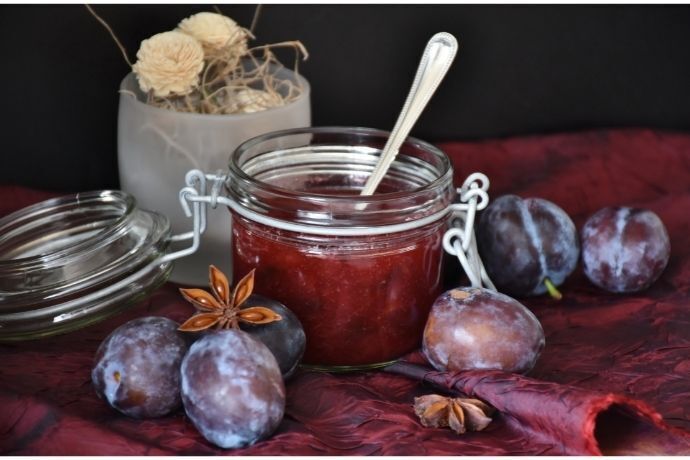
With very few calories, plums are a great choice for healthy snacks and desserts. When you're hungry, just choose from yellow, black, green, red or dried plums. Discover some wonderful recipes below.
Ways to consume the fruit
Extremely versatile, plums can be eaten pure, fresh or added to a wide variety of culinary preparations. They are perfect baked, grilled or sautéed. Here are some ideas for you to start including this fruit in your diet:
- Make a delicious fruit salad;
- Prepare a sweet and sour sauce for meat;
- Flavor the water or tea with a slice of plum;
- Cut it into small cubes and add it to yogurt or granola for breakfast;
- Vary the dessert with a surprising smoothie (fruit shake).
Dried plums are also ideal for making puddings, cakes and cookies, as they can replace fats and sugar in recipes.
Recipe for homemade plum jam
Homemade jellies are the kind of recipe that are a delight to prepare and enjoy, as they have a taste of country cooking, of grandma's house. They're perfect for a family snack and a great idea to give to someone with a lot of affection.
It's also the ideal preparation for riper plums, which are almost past their prime. Always sweet, it's wonderful on toast and cookies. It's as if the food is hugging you, so cozy is the taste. Check out the foolproof recipe for homemade plum jam:
Ingredients
- 2 kg of fresh red plums (can be replaced with another variety, adjusting the amount of sugar);
- 1 cup of water;
- 4 cups of sugar;
- Lemon juice;
- 1 cinnamon stick.
How to do it
The first step is to wash the plums well, then cut them into cubes of about 1 cm, removing the stones but keeping the skin. Put the cubes of fruit in a large saucepan, add the lemon and water. Mix a little and bring to the boil. As soon as it comes to the boil, add the sugar and the cinnamon stick.
Leave the mixture to cook over a medium heat, with the pan uncovered. It is important to stir frequently so that the jam does not stick to the bottom of the pan. Use a slotted spoon to remove the foam whenever it appears on the surface.
Cook until it reaches the point of jelly, about 1 hour and 20 minutes. The tip to confirm the point is to put some of the jelly on a saucer and draw a line with your finger. Tilt the saucer and if you can see the bottom of the dish without the mixture covering everything, you can turn off the heat.
The next step is to put the jam in sterilized glass jars, cover them and turn them upside down until they have cooled completely. This way, it will last for up to 2 months, tightly closed and at room temperature. In the freezer, it will last for 6 months. Once opened, you can consume it for up to 1 month by storing it in the fridge.
Plum juice recipe
Very healthy, practical and tasty, plum juice will turn you into an unconditional fan of the fruit. It is ideal to accompany meals such as lunch or dinner, but can be consumed at any time, even to cool off on a hot summer's day.
So grab a pen and paper and write down the recipe for a perfect juice packed with health benefits.
Ingredients
- 6 fresh black plums (can be replaced with another variety, adjusting the amount of sugar);
- 500 ml of water;
- Sugar to taste;
- Crushed ice (optional).
How to do it
Preparing plum juice is very simple: just wash the fruit well, remove the stones and chop it roughly, just to help the blender when blending. Keep the peel on to make the drink more nutritious.
Then add the plums, water and sugar to a blender and blend until smooth. Strain and add crushed ice if desired.
Plum tea recipe
Plum tea is not very popular, but it is an excellent alternative for obtaining the properties and benefits of the fruit. With its laxative action, it helps to treat intestinal problems such as constipation.
In addition, the infusion helps the metabolism to function properly and improves mood, as it stimulates the production of serotonin (known as the hormone of happiness and well-being). It is an excellent treatment for anxiety, and another advantage is the elimination of gas. Here's how to prepare this super-powerful tea and enjoy all its benefits.
Ingredients
Plum tea is made with the dried fruit to maximize its benefits. Check out what you'll need:
- 3 prunes;
- 250 ml of water.
How to do it
To prepare the tea, the first step is to remove the stones from the plums and put them in a pan with the water. Bring to the boil and let it simmer. When the fruit begins to break down, mash it well. Then pass the mixture through a strainer and wait for it to cool before serving.
The tip is to drink the beverage on an empty stomach and avoid excessive consumption, as the laxative effect can cause a loss of mineral salts and nutrients. In addition, people with irritable bowel syndrome should not drink the tea.
Other information about the plum
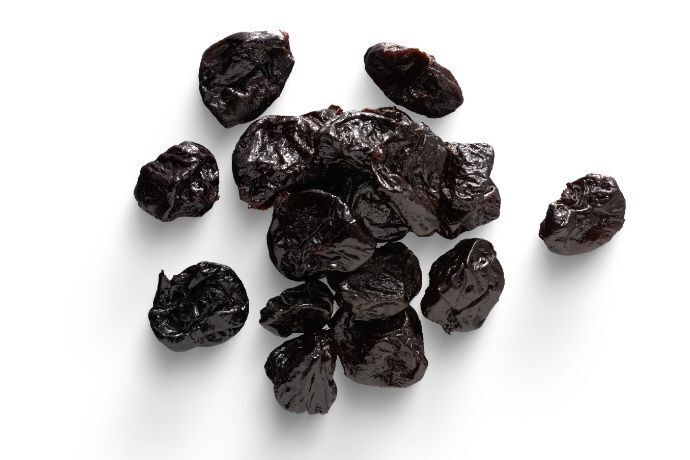
A fruit with a unique, striking and pleasant flavor, the plum is enjoyed by thousands of people around the world. Consumed fresh or dehydrated, it is present in desserts and even as an accompaniment to savory dishes. Check out how many units you can safely eat below.
What is the daily recommendation for plums?
The recommended daily intake of plums varies according to the color of their skin. One or two green, red or black plums are ideal, while yellow plums can be eaten in ten pieces.
In the case of prunes, it is recommended to eat three to four units or around 40 grams a day. However, it is worth noting that the quantities may differ when taking into account age, gender and state of health.
Risks and contraindications of plums
Excessive consumption of plums should be avoided, as the fruit contains oxalate, a substance that can form crystals in the urine, causing kidney stones. In addition, the presence of insoluble fiber can cause or worsen diarrhea.
The opposite effect is also possible, as increased fiber consumption without sufficient fluid intake leads to constipation. Another point to watch out for is the presence of traces of histamine, a compound that causes allergies.
How to buy and store plums
When shopping, look for plums that are firm, but give a little when gently squeezed. As for storage, if the fruit ripens too quickly, just put it in the fridge.
Another option is to freeze them, but in this case you need to remove the core first. However, if they take a while to ripen, put the fruit in a paper bag and leave it at room temperature for a day.
Dried plums, on the other hand, can be stored for longer, lasting up to 6 months at room temperature or 1 year in the fridge, as long as they are in a closed container.
Enjoy all the benefits of plums!

Plums are a very nutritious fruit, packed with health benefits. Both fresh and dried, they are an excellent source of vitamins, minerals, fiber and antioxidants. The most famous positive point is their positive effect on the intestinal tract.
In addition, they have several characteristics that reduce the risk of chronic diseases such as osteoporosis, cancer, anxiety, diabetes and cardiovascular diseases. With a delicious taste, they are very easy to incorporate into your diet. Your body will thank you!

